Has Inflation Peaked?
Monthly Market and Economic Update – January 2023

Peter Flannery Financial Adviser CFP
“If you have one economist on your team,
it’s likely that you have one more than you’ll need.”
Warren Buffett
Key Points:
- Inflation appears to be moderating.
- Interest rate hikes in the US could slow.
- Interest rate rises in NZ may take longer to slow.
- Earnings revisions (company announcements coming in below market expectations) will be key for market direction short term.
THE MARKETS
2022… a volatile year and unusually so
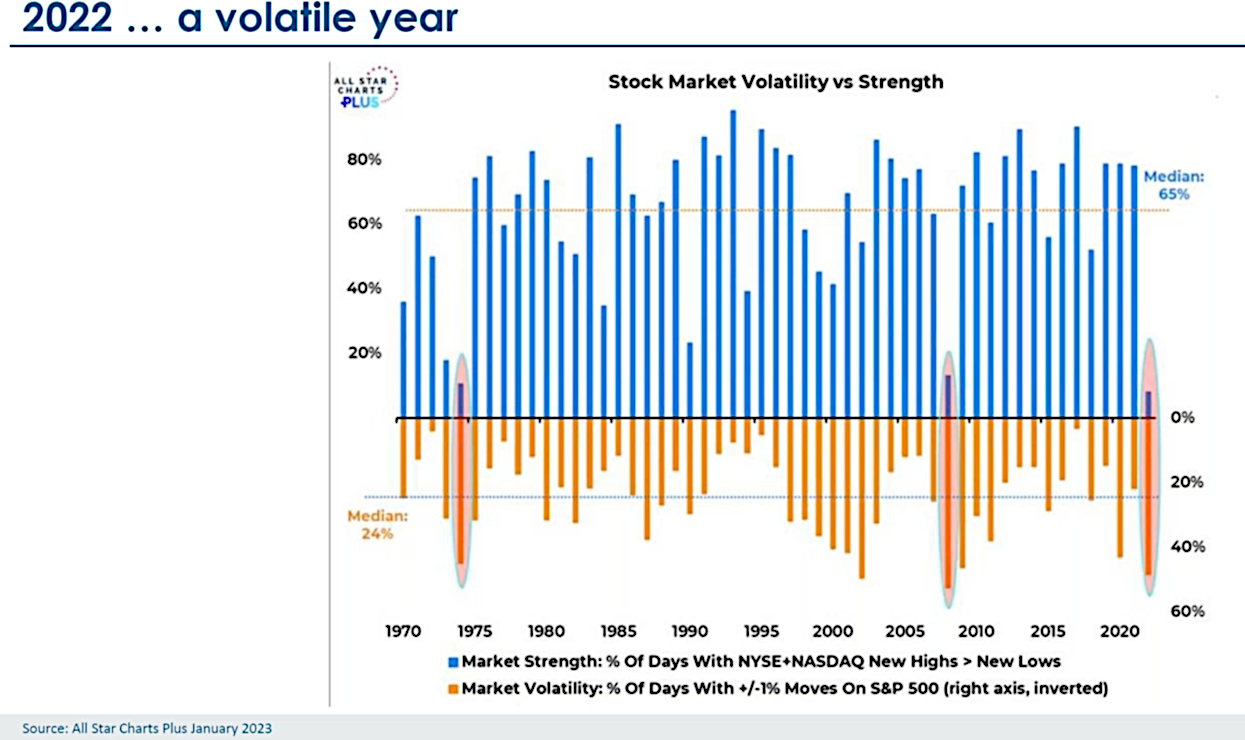
The above graph (Source: Harbour Asset Management New Zealand) shows market volatility. The blue lines represent the percentage of days that the American share market reached new highs compared to new lows. The orange bars show the percentage of days with a movement of +/-1% on the S&P 500.
We know that 2022 was volatile. What may be less obvious is the fact that the movements in market prices was similar to those in terms of variability to 2008 and slightly more volatile than when we look back to the 1970s, when inflation rose strongly. Look closely at the graph and you’ll see those highlighted bars above 1975, 2010 and the one to the far right of the graph. To be clear, 2022 was a volatile year (I know … you know that already, right?)
So what does this mean?
Simply, we are in the midst of a market correction which is not over.
We could for example see markets touch on new lows (the last one was October 2022) if unexpected negative data emerges. I’m watching the likes of inflation data, interest rate announcements, earnings announcements and the narrative around the prospects for another recession (America had one in 2022 already).
At the same time, in the absence of strong negative shocks, then we could also see, particularly when we look back in 2024, that 2023 could be the early stages of the upward trend in market prices, albeit in a volatile uneven way.
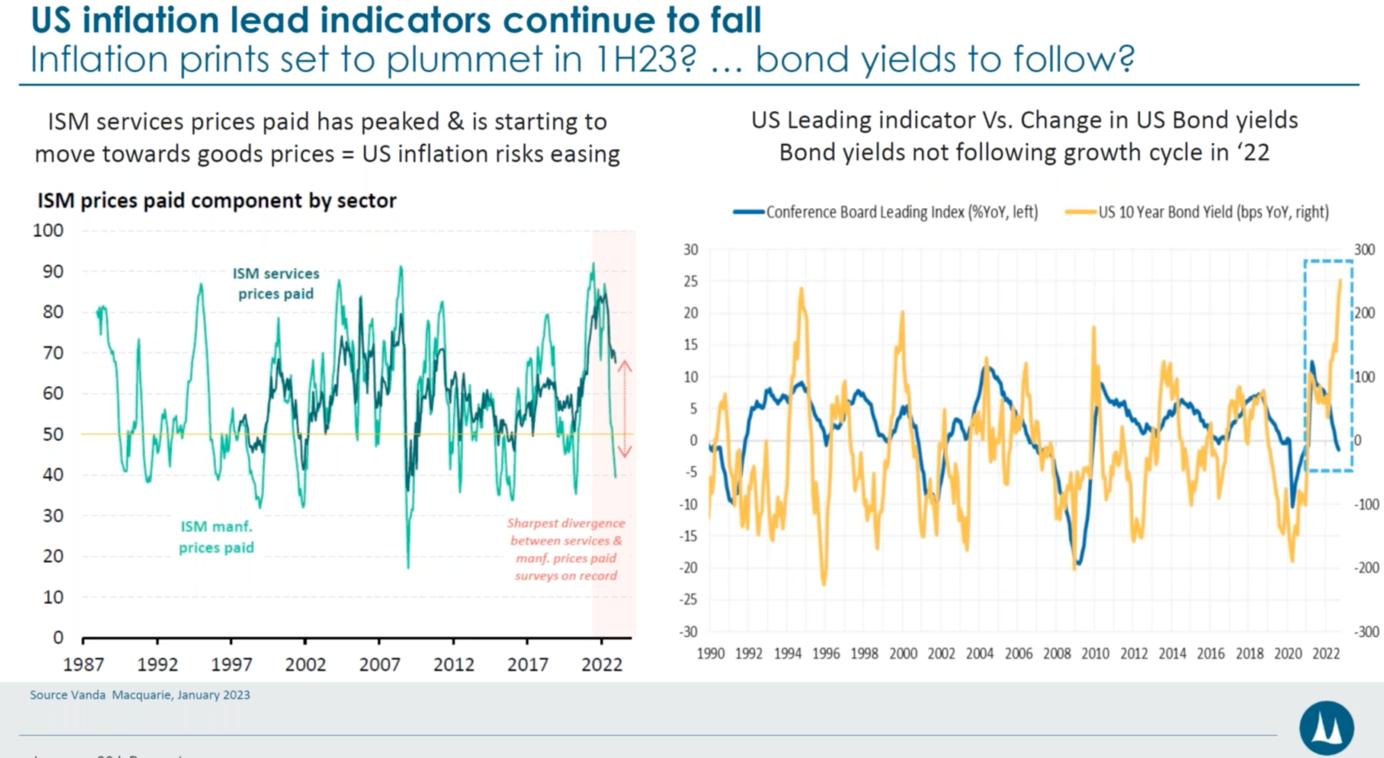
The graph to the left above (Source: Harbour Asset Management New Zealand) compares the cost paid for services in the US, with prices paid for manufacturing. The graph to the right compares the Conference Board Leading Index which is effectively economic growth, with the 10-year bond yield.
Looking more closely at the chart on the left above, notably to the right side of that graph, the gap between those two indicators is significant. This suggests further reductions in inflationary pressures that could lead to slower inflation growth over the next quarter or two.
Still with that left side graph, from 1997 and we can see that those two lines are generally well correlated (move in a synchronised fashion together) which is why that gap is so interesting.
In terms of your investment portfolio, this is relevant because lower inflation may mean the US Fed can slow down interest rate hikes which the market might like. It is only one piece of data however it is an important one.
Looking to the chart on the right which compares the Conference Board Leading Index (basically forecasting economic growth) with 10 year US bond yields (the orange line), again you can see that up until 2022 those two indicators were generally well correlated. Once again, we can see a significant gap. Arguably bond holders may start to look through interest rate hikes to declining economic activity which could see bond yields (the orange line) start to decline.
Thinking this through a little bit further, think about a recession and what impact it might have on that orange line.
Slowing economic growth does not mean rising interest rates generally. It means the opposite. So, the point here is that there are indicators which suggest inflation is moderating. Interest rate rises in turn would therefore moderate although it would likely play out over a period of months potentially. This is not my prediction but simply articulating what the data suggests. What do you think?
The US Dollar

The above graph (Source: Visual Capitalist) tracks the US dollar movement over the last 50 years or so.
Whilst we invest in businesses rather than play the markets, taking currency into account is important every time we buy or sell an asset. Particularly so when markets become volatile.
This is important because, at WISEplanning we favour investing in quality businesses and those are more readily available in America when compared to many other countries. Also, there is no language barrier and generally we can rely on the information provided. Investing directly in Chinese businesses on the other hand is entirely possible but not quite as transparent or simple.
Anyway, the US dollar as the graph shows (to the right of the above graph), has been rising against most other currencies, particularly in the latter part of 2022 which of course means that US dollar-based assets become expensive where purchases are made from New Zealand dollars. That’s why we slowed down on US dollar asset purchases over the latter part of 2022.
More recently we can see that the US dollar has eased back somewhat. This is a bit of a double edge sword in some ways because a declining US dollar means that our US dollar-based assets are theoretically losing value against the New Zealand dollar.
Of course, we don’t just invest in a time capsule of a few months but over the long-term which is why currency fluctuations to some degree are less of an issue longer term. Important though to take into account every time we make a move.
Recently, I have suggested to my clients generally that the US dollar/NZ dollar cross rate at 65 cents might be a reasonable threshold at which point we could consider continuing to purchase US dollar-based assets (although every investor’s situation is slightly different).
On another note, looking more globally, we can see that the world continues to battle against high levels of inflation which inevitably, if not already, will peak.
Meantime though, central banks around the world will need to ‘keep their foot on the gas pedal’ so to speak with regards to rising interest rates.
As has been stated many times across the markets, what a mistake it would be, particularly for the US Central Bank to ease up on interest rate rises too early. That could see a resurgence of inflation at a much higher level, making it more difficult to contain.
That would mean much more volatility for markets and a lot more pain for everyday citizens, not only on low incomes, but also those in the so-called middle class.
Wages and salaries simply do not stretch as far in that scenario. Hopefully central bankers will see the job through and contain inflation.
For us, as I’ve mentioned elsewhere previously, we don’t want to be late with our investing.
It’s important that we invest with the long-term outcome in mind. That may mean investing in more growth assets in the face of volatility as we progress.
Quality businesses will still see their trading price move up and down, sometimes quite sharply and significantly. We’ve seen this with large tech companies such as Alphabet, Google and Apple. These are strong businesses that are well-positioned but they can still fall out of favour with the market. This is what determines the trading price every day.
As you know the idea is to focus on the quality of the business rather than the trading price movement, particularly in the short-term.
So what drives the US dollar?
- Rising inflation
- Rising interest rates
- Safe haven status – people turn to American dollars during market uncertainty
- Economic growth – historically the US has demonstrated reliable economic growth long-term
The Global Economy
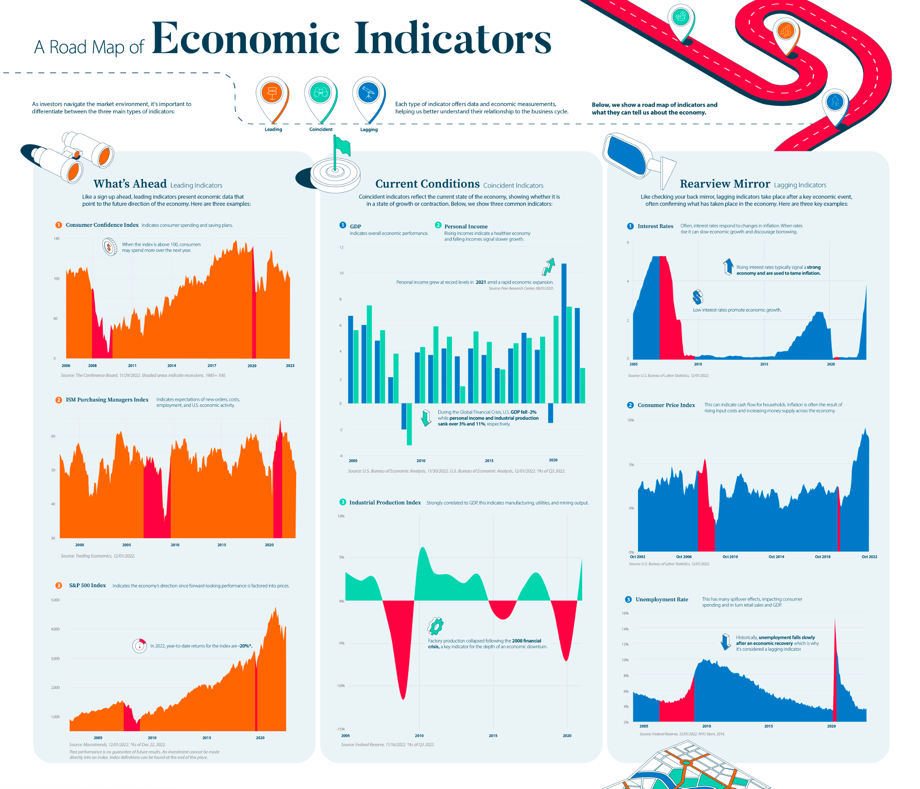
The above table highlights a number or economic indicators that we may use to gauge where things are at and where global economy might be heading. Don’t worry about reading it. It’s the headings that are of interest rather than the detail.
Global economic growth remains at a slow pace as central bankers around the world continue to battle inflation. That means rising interest rates and slowing economic growth. It may also mean a higher level of unemployment.
You could consider this to be the medicine that the economy and its everyday citizens must consume in order to help get inflation under control. It doesn’t feel good or taste nice, but it works.
For example, we’ve seen a number of lay-offs in the US tech sector, with Alphabet (google) recently laying off around 10,000 of its workers, although that is quite a small percentage of their over-all workforce.
The general expectation is for the global economy is to slip into recession over 2023. High levels of inflation and rising interest rates will contribute and so too will slowing economic activity.
China’s outlook has improved somewhat as the government steps away from it’s Zero-COVID policy although living with COVID will present its own challenges for the Chinese government.
There are early signals in a number of economies around the world that suggest the spike in inflation could be easing.
At the same time though, the world has a long way to go to bring inflation under control.
That’s why we’ll likely see subdued and at times sluggish economic growth as the global economy contends with inflation and interest rates at elevated levels, potentially right across 2023 and into 2024. Stagflation (persistently high inflation, high unemployment and ongoing low growth) remains an item for us to consider as we go along.
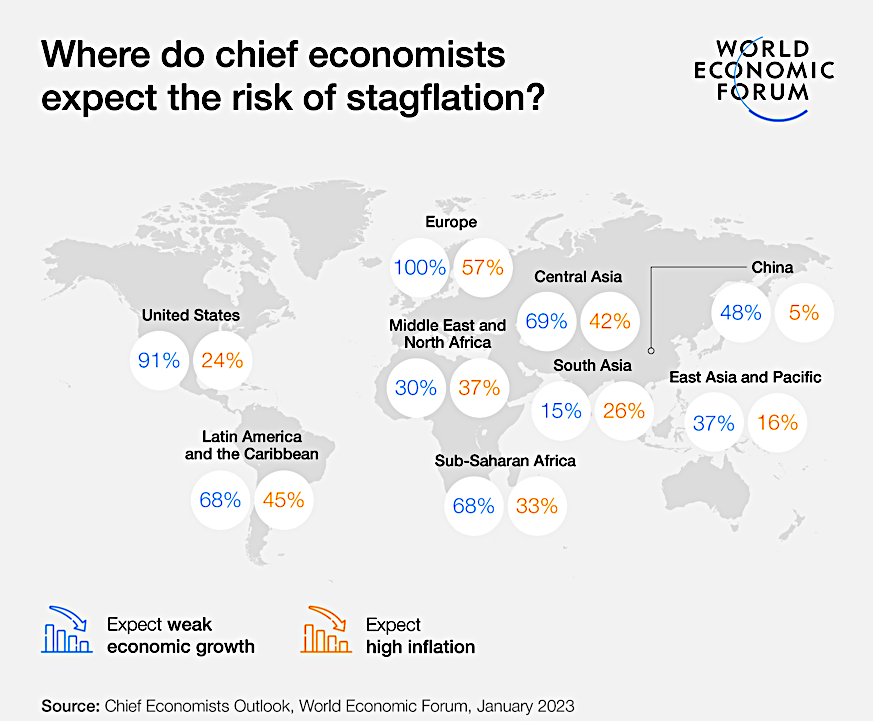
The United States of America
Inflation – USA
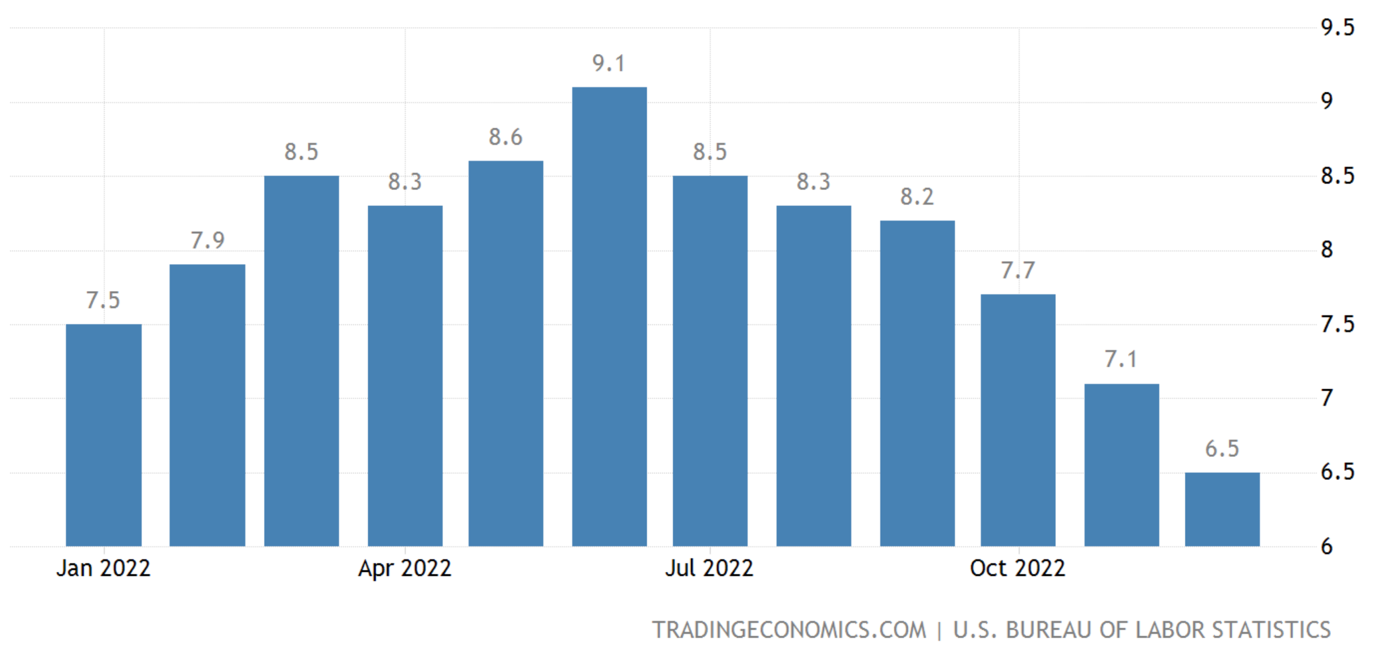
The above graph tracks the inflation rate in America.
Inflation as I’ve mentioned appears to be moderating in the US with the annual inflation rate slowing for the 6th straight month to 6.5% in December 2022. This is the lowest level since October 2021 and is line with most market forecasts. It follows a 7.1% number in November 2022.
Interest rates – USA
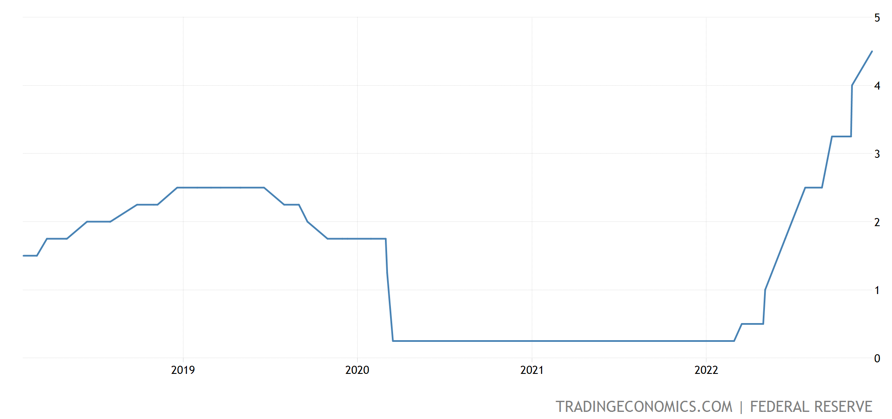
The above tracks interest rates in the US.
The US Federal Reserve Governor Jerome Powell increased the Fed funds rate by 50 basis points (half of 1%) on the 15th of December last year. This is interesting because from an investment point of view, markets are looking for a signal that interest rate rises will be slowing down and indeed what the market really wants is any signal of an interest rate cut.
This is particularly interesting because an interest rate cut is good news on the one hand because it means lower borrowing costs which the market likes and responds to by lifting trading prices. On the other hand though, there is some evidence showing that a rate cut can lead to lower trading prices, possibly because lower interest rates may also signal slowing economic activity (it’s a bit of a mixed bag).

The above table shows the S&P 500 movement over various time spans.
The point about the above graph is that, generally lower interest rates mean higher trading prices however what causes those low interest rates could be for example sluggish economic activity or recession (it’s complicated!).
Well, it’s not overly complicated, the market tends to overreact in the short-term.
As for you and I, it’s simply a matter of taking advantage of lower trading prices without becoming overly academic about the nuances of the market’s interpretation of changes in economic data from day-to-day.
Unemployment – USA
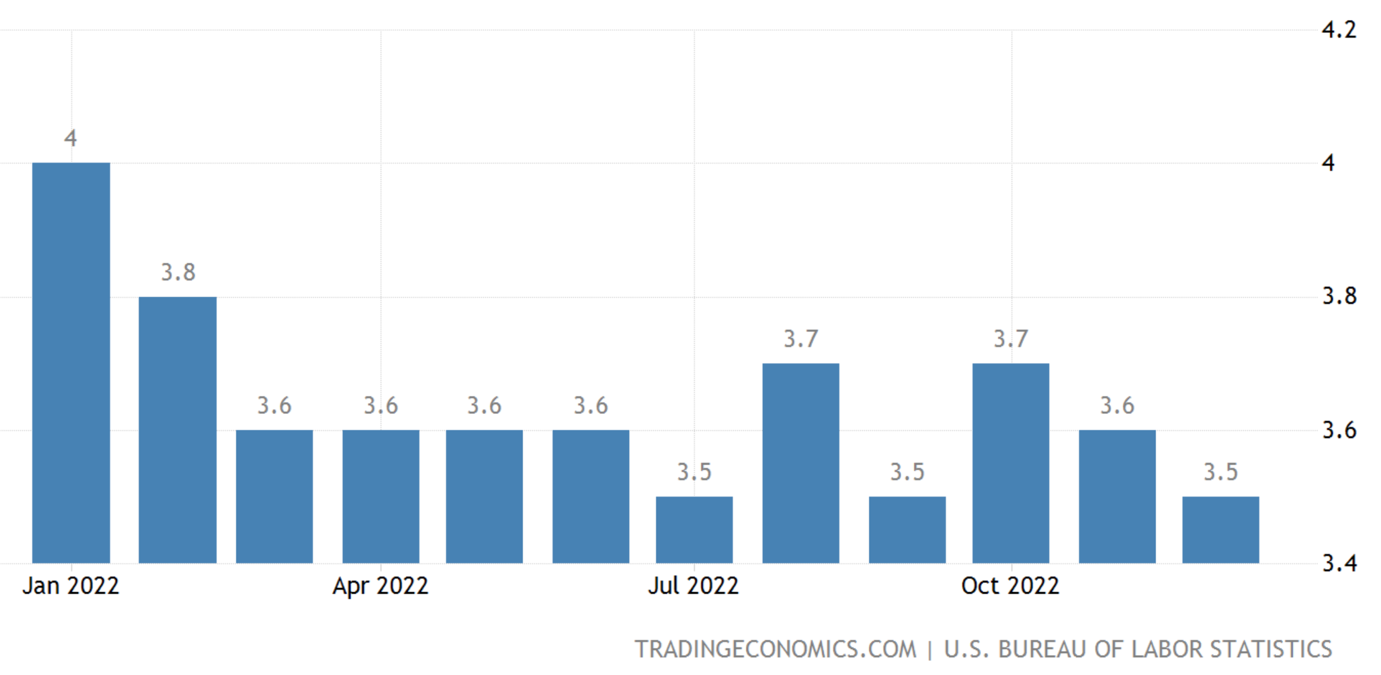
The above graph tracks the unemployment rate in America.
Unemployment is another key indicator for the US Federal Reserve. Although estimates vary, some estimates suggest that unemployment in America needs to reach somewhere between 4.5% and 6% in order to slow down the economy enough for the US Fed to be comfortable that inflation will slow down and stay down.
In simple terms, unemployment remains too low at the moment.
The American economy continues to grow albeit at a sluggish pace and may well slip into recession this year. The market will both love it and hate it. Hence choppy sideways for markets looks like being a theme for this year.
Britain
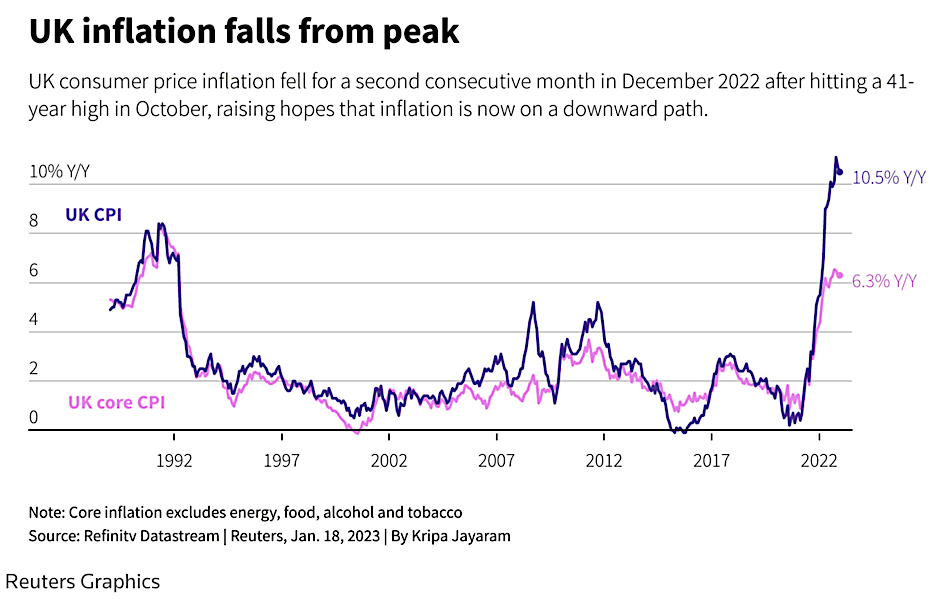
The above graph tracks UK inflation.
Like elsewhere in the world, Britain is facing high inflation which is not good for small business and everyday consumers.
The Consumer Price Index fell for the second month in a row in December last year after having hit a 41-year high in October last year. This suggests that inflation may have peaked.
I suspect however that like elsewhere, the battle with inflation is far from over. The UK Finance Minister Jeremy Hunt has been resisting pay demands from public sector trade unions. No wonder he’s been resisting it when you think that retail price inflation is used as a benchmark in some pay talks and sits at around 13% (at least that’s down from 14% in November last year).
This tension exists anywhere there is inflation. Everyday citizens are squeezed by rising costs. Their salary or the interest off their term deposits simply don’t go as far. As for the government, in order to get things under control, unfortunately one of the tools they use is to raise unemployment and reel in wage rises.
Looking ahead, the expectation is that the central bank in the UK will look to raise interest rates 0.5% up to 4% in February this year, up from the current 3.5%.
Although painful now, the central bank will need to hold the line and continue to raise interest rates among other measures to ensure that inflation is brought back under control. It will take time.
New Zealand

Steady as we go here in New Zealand. Not much change in those numbers above from the last time I reported.
One notable change is the stepping down of Jacinda Ardern as Prime Minister of New Zealand.
Markets didn’t move much as a result of the news. Interestingly though Jacinda Ardern received worldwide coverage, most of which was positive. That’s a good thing because it helps put New Zealand on the global map.
As for New Zealand in the future, whilst it won’t be a walk in the park for National, one would think they now have a better chance of taking government back from the Labour Party in the upcoming election planned for October this year. Not far away!
As for what this means for us as investors, simply, minimal change at this stage for us.
For property investors though, National pledged to bring back tax deductibility for interest, as well as adjust the bright line test and so they may well have the opportunity to do just that after October elections.
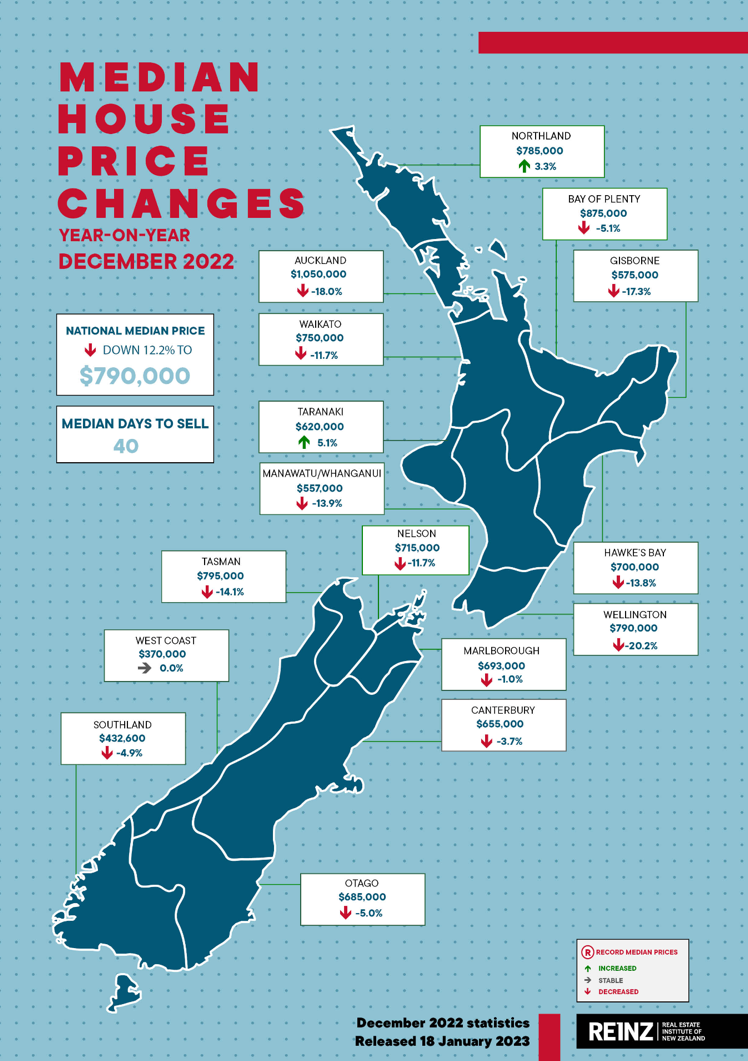
Residential property prices are declining in a more uniform fashion as rising interest rates impact in a more meaningful way. It’s not over.
We would need to go back a long way to find where we first started talking about how excessively overpriced residential property has been, not only in New Zealand but in a number of other countries (e.g. UK, Canada). The other point worth mentioning is how long residential property prices have remained unusually expensive which is still the case today.
For property investors though, providing the methodology is sound and fundamental, no cause for concern with property prices declining. Indeed, with sensible financing (e.g. including table mortgages like I’ve been suggesting for decades), keeping debt at sensible levels, residential property for those that are happy to invest in that area remains an option, regardless of declining house prices. That’s because the investment nature of property does not change with house prices rising or falling. Lower prices allow the value to emerge and also provides special situations that can improve buying significantly.
By the way, the next monetary policy statement is scheduled for February the 22nd, 2023. Another increase in interest rates looks likely. I will keep you posted.
To Summarise …
Inflation remains a global problem for most central bankers apart from China. Their issue will likely be ensuring they stay away from deflationary conditions. I still wonder whether their lockdown COVID policy was at least partly for the purpose of combating inflation?
China’s economic growth has slowed understandably as a result of the COVID lockdowns. The Chinese government I believe will be very focused on maintaining economic growth. No easy task.
The US Federal Reserve continues to signal further interest rate hikes ahead, reiterating their firm commitment to combating inflation – absolutely!
Central bankers around the world appear united in their battle against inflation which bodes well for everyone else as eventually inflation will be brought under control.
Although difficult to predict, we know there are some signs of inflation increases moderating and that means interest rate rises may also moderate as well.
As for the markets, as always they look for the slightest signal of lower interest rates and improving economic growth although, I believe they will be challenged by some earnings revisions which will be key over the next two to three quarters. A significant earnings revision to the downside would create strong volatility.
Overall though, current data suggest that, whilst a recession in America looks inevitable, current indicators suggest it won’t be lengthy nor will it be deep. Of course, this can change but that’s how things look at the moment.
All that said, there is quite a long way to go to get inflation under control and we’ll see inflation remain elevated likely over much of 2023 and into 2024.
As inflation continues to moderate, if that is the case, then interest rate rises will slow down and markets will like it. Until that is, the market sees slowing economic growth and then it may decide that it’s no longer happy. This is simply part of that sideways choppy environment that I mentioned earlier a couple of times.
The bottom line is that we are on track. The global economy continues to grow, albeit slowly and markets continue to remain volatile which of course is the market’s doing what they should. Steady as we go …

